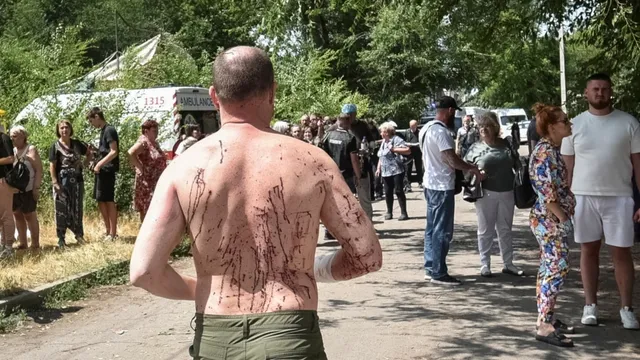
Death toll rises to 22 after a relentless Russian missile attack in Ukraine
2025-06-27 10:15- A Russian missile strike on Dnipro resulted in at least 22 deaths and over 300 injuries.
- Ukrainian President Volodymyr Zelensky is advocating for enhanced military support from NATO allies.
- The ongoing conflict's humanitarian impact raises urgent calls for international action.
Express your sentiment!
Insights
On June 25, 2025, Ukraine faced severe devastation due to a Russian missile attack in the Dnipropetrovsk region, particularly affecting the city of Dnipro. With at least 22 fatalities reported and over 300 individuals injured, this incident marks another tragic episode in the ongoing conflict between Ukraine and Russia. The strikes, which occurred during daylight, targeted civilian sites, leading to significant destruction, including damage to educational and medical institutions. Reports indicate that among the injured were numerous children, underscoring the humanitarian impact of these actions. In the wake of these events, Ukrainian President Volodymyr Zelensky has highlighted the importance of bolstering Ukraine's defense capabilities at the ongoing NATO summit. He emphasized the potential threat posed by Russia, warning that attacks on NATO member countries could occur within five years if support for Ukraine is not strengthened. This scenario illustrates the urgency in which Zelensky is seeking international assistance to fortify his country’s military against the ongoing Russian advances. The localized assault is part of a larger strategic onslaught that Russia has executed repeatedly during its full-scale invasion of Ukraine. This particular strike was highly coordinated and executed with precision, showcasing the ongoing tactics employed by the Russian military to sow chaos and destabilize Ukraine further. Ukrainian authorities have condemned these assaults as war crimes, asserting that the international community's response must be firm to address the humanitarian crisis resulting from such military actions. As the conflict continues, the city of Dnipro has become a crucial site for internally displaced persons and volunteers. The heartbreaking scene of devastation speaks volumes of the widespread consequences of military aggression in densely populated areas, which international observers argue is predictably harmful to civilians. With Ukraine’s defense forces claiming some success in stabilizing front lines in other regions, the situation remains dire as the nation grapples with the immediate aftermath of this missile attack and lobbies for international support to prevent further tragedies.
Contexts
The conflict in Ukraine, which began in 2014, has seen the Russian military employ various strategies that reflect both traditional warfare principles and hybrid tactics. The initial phase of the conflict was marked by the annexation of Crimea, where Russia utilized a rapid deployment of special forces and local militia known as "little green men." This unconventional approach allowed Russia to seize control of key territories without a formal declaration of war, highlighting a strategy that merges psychological operations with conventional military maneuvers. The near-simultaneous disinformation campaigns aimed at undermining Ukrainian state legitimacy were also a crucial part of this strategy, creating a fog of war that obscured Russia's actual intentions and capabilities in the region. As the conflict escalated into a full-scale war, the Russian military adapted its strategies to include more conventional warfare elements, including the use of armored divisions, artillery deployments, and air support. Notably, the conflict has also illustrated an increase in hybrid tactics, which combine cyber warfare, misinformation, and the use of proxy forces. Russia's cyber operations have targeted Ukrainian infrastructure, governmental institutions, and critical information systems, aiming to disrupt communications and sow discord both domestically and internationally. This multifaceted approach complicates responses from NATO and Western allies, who are constrained by legal and operational norms against engaging in hybrid warfare, making it challenging to implement a unified strategy in response to Russian aggression. In the ongoing conflict, the use of 'frozen conflict' strategies has also emerged as a significant Russian tactic. By maintaining a prolonged state of low-intensity conflict in eastern Ukraine, Russia has succeeded in creating geopolitical leverage against Ukraine and the West. The presence of Russian troops and equipment in the Donetsk and Luhansk regions, coupled with a sustained reinforcement of local separatist forces, allows Russia to exert influence while avoiding full mobilization and international condemnation. This strategy effectively keeps Ukraine in a state of vulnerability and uncertainty, as the ongoing conflict precludes any definitive resolution and maintains pressure on its economy and military resources. Concurrently, Russia's military strategy emphasizes the importance of logistical capabilities and modernization efforts. Over the years, the Russian military has invested substantially in improving its supply chains, intelligence, and communication capabilities, ensuring a swift and adaptable response to evolving battlefield conditions. Collaborative exercises with armed forces from allied countries, along with partnerships within the Collective Security Treaty Organization (CSTO), serve to bolster Russia's operational readiness. As the conflict extends into new phases, the integration of advanced technologies, including drones and precision-guided munitions, underscores an emphasis on modern warfare tactics, enabling Russia to maintain a competitive edge against Ukrainian forces. This blend of traditional and modern military strategies positions Russia as a formidable adversary in the ongoing conflict, with significant implications for regional stability.